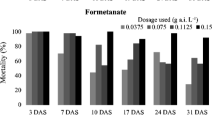Abstract
The persistence of 34 formulations in the green (G) and red (R) berries of C. arabica var. typica, infested with female adult H. hampei were assayed by a dip-technique. The 3-day LC50 values in G and R (figures in parentheses) berries for thiodan EC 35 were 0.00284 (0.00327), and the relative ratio of values for other formulations were: perfekthion 1.2 (2.1) > carbicron 1.6 (2.3) > basudin 3.5 (3.2) > actellic 4.0 (3.6) > decis 4.1 (3.7) > thiodan EC 3 4.2 (4.2) > bidrin 5.8 (5.0) > malathion 5.8 (5.1) > lindane 5.8 (5.6) > ciodrin 5.9 (5.6) > folimat 6.0 (6.0) > belmark 6.2 (6.3) > aldicarb 8.0 (9.7) > nexion 11.0 (12.0)>kelthane 13.5 (15.4) > tiovel 14.6 (16.3)>dursban 15.6 (22.0) > chlordane 17.8 (23.8) > methomyl 21.5 (24.3) > aldrin 25.1 (24.9) > supona 27.2 (26.5) > dimilin 29.0 (27.5) > methoxychlor 31.7 (92.2) > chlorfenvinphos 35.8 (92.5) > dieldrin 41.2 (93.8) > phosdrin 65.0 (94.7)>sevin 104.2 (118.0)> nexagan 106.4 (121.9) >bimarit 196.4 (301.7) > azodrin 271.2 (410.4) > fenitrothion 448.3 (417.0) > chlorpyrifos 448.8 (614.3) > gardona 514.6 (703.1), -fold more than the thiodan EC 35 values.
The 7-day LC50 values for 29 formulations were ca 10–82% less than those of the 3-day values; the decrease in the values for leading formulations being thiodan EC 35 13.4 (8.3), perfekthion 6.5 (39.9), carbicron 12.4 (10.6), thiodan EC 324.3 (16.4), malathion 35.2 (25.7), lindane 82.1 (76.9) and tiovel 59.6 (67). The values for the 17 least toxic formulations (except dimilin and bimarit) showed ca 27–88% decrease during the last 4 days of observations.
Similar content being viewed by others
References
Almeida P. R. and Cavalcante R. D. (1964) Ensaio de campo com novas insecticidas organicos no combate a broca de cafe, Hypothenemus hampei (Ferr. 1867). Archos Inst, biol., S Paulo 31, 85–90.
Almeida P. R., Pigatti A. and Arruda H. V. (1980) Alguns no va productos aplicados em ensaio de campo contrôle a broca, Hypothenemus hampei (Ferr, 1867), do cafe. Resume, I.B.C. Congress, Brazil, Vol. 8, pp. 67–69.
Amarai S. F., Arruda H. V. and Orlando A. (1973) Some insecticides and coffee liquor. Archos Inst, biol., S Paulo 40, 173–180.
Amarai S. F. and Oliviera D. A. (1974) The behaviour of some chlorinated insecticides for the control of coffee berry borer H. hampei (Ferr. 1867). Secao de Pragas des Plantas Alimenticias Basices e Olericolas, instituto Biologio, Sao Paulo, Brazil Vol. 40, pp. 106–110.
Bardner R. (1978) Pest control in coffee. Pestic, Sci. 9, 458–464.
Busvine J. R. (1971) Techniques for Testing Insecticides. Commonwealth Institute of Entomology, London.
Evans D. E. (1965) The coffee berry borer control in Kenya. Kenya Coff 134, 15–21.
Hernandez-Paz P. and Penagos D. H. (1974) Evaluation of a system of low volume application, in the control of the borer of coffee fruit. An. Cafe 134, 15–21.
Ingram W. R. (1968) Observations on the control of the coffee berry borer Hypothenemus hampei (Ferr) with endosulfan in Uganda. Bull. ent. Res. 57, 539–547.
Lepage H. S. and Giannotti O. (1950) The action of some modern insecticides on the coffee berry borer. Archos Inst. biol., S Paulo 19, 299–308.
Le Pelley R. H. (1969) Pests of Coffee, pp. 116–138. Longman, London.
Liceras Z. L. and Farge G. G. (1975) Chemical control of the coffee berry borer with early and late applications in Tingo Maria. Revta perù. Ent. 17, 78–80.
Maier-Bode H. (1968) Properties, effect residues and analytics of the insecticide endosulfan. Resid. Rev. 22, 1–37.
Mansingh A. and Rhodes L. F. (1983) Bioassay of various formulations of insecticides on the egg and larval stages of the coffee berry borer Hypothenemus hampei Ferrari (Scolytidae: Coleoptera). Insect Sci. Applic. 4, 223–226.
Penados-Robles R. and Ochoa M. H. (1978) Evaluation of insecticides in the control of the borer of coffee fruit in the republic of Guatamala. In Symposium on Coffee Cultivation, pp. 25–37. Curoa Reuniones, IICA 184, Guatamala City.
Rhodes L. F. and Mansingh A. (1981) Susceptibility of the coffee berry borer Hypothenemus hampei to various in-secticidal formulations. Insect Sci. Applic. 2, 227–231.
Thomson W. T. (1980) Agricultural Chemicals, Book I, Insecticides. Thomson Fresno, California.
Author information
Authors and Affiliations
Rights and permissions
About this article
Cite this article
Mansingh, A., Rhodes, L.F. Residual Toxicity of Various Insecticidal Formulations to the Coffee Berry Borer, Hypothenemus Hampei Ferrari (Scolytidae: Coleoptera). Int J Trop Insect Sci 6, 209–212 (1985). https://doi.org/10.1017/S1742758400006652
Received:
Published:
Issue Date:
DOI: https://doi.org/10.1017/S1742758400006652




